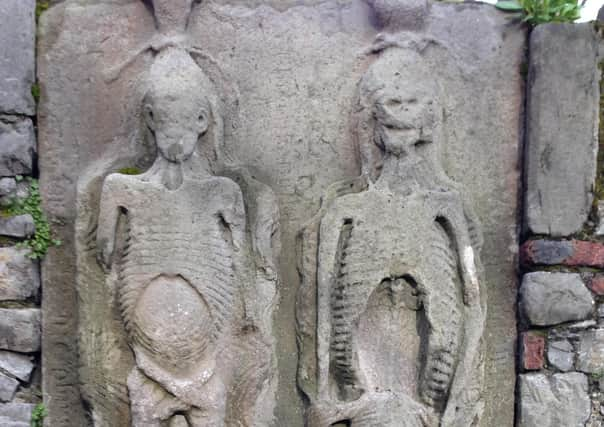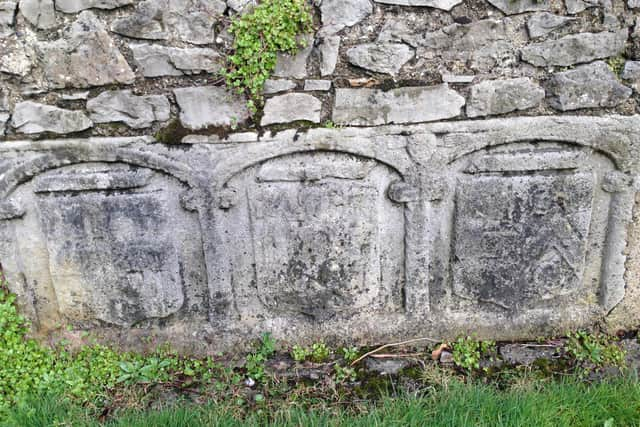Emaciated man and wife carved in stone recall gruesome plague


You know the kind of thing - a tale from days of yore that’s common knowledge, or it should be, but it has passed you by.
Story-teller and author Doreen McBride’s quirky but authoritative local-history books have often featured on this page and her latest publication, about Banbridge, will get an airing here soon. But a recent email from Doreen was about some very striking sculpted stone memorials in Ireland which I’d never previously known about or visited.
Advertisement
Hide AdAdvertisement
Hide AdFormerly a biology teacher at Wallace and Dromore High schools, Doreen lives in Banbridge but regularly navigates Ireland’s highways and byways in search of local history and mythology for her books.


Before describing the intriguing tombstones in St. Peter’s Anglican Church in Drogheda, Doreen put our Covid-19 pandemic into its historical context, long before the tragic, post-WWI global influenza. “The more I think about it,” she explained “the more I feel grateful not to be living in the dark ages when Europe’s population was decimated by bubonic plague, also called the Black Death.”
Back then “there was no scientific knowledge to fall back on, no treatment and no means to stop it spreading,” her e-mail continued, “so it must have been even worse than our present nightmare!”
Please don’t read Doreen’s description of the symptoms of the Black Death if you’re about to have a meal, or are wanting a good night’s sleep any time soon.
Advertisement
Hide AdAdvertisement
Hide Ad“Bubonic plague causes the body’s lymph glands to swell forming painful buboes (large, inflamed lumps).


“Parts of the extremities, such as the tips of noses, fingers and toes may become gangrenous and the patient develops a high fever and may vomit blood continuously. When it gets into lungs it becomes the highly contagious pneumonic plague which can pass through the air from human to human.”
Doreen’s email continued with some more extremely unnerving aspects of the Black Death before recounting the sad story behind Drogheda’s two poignant tombstones.
She referred to the old saying ‘Eat, drink and be merry for tomorrow we die’ which “hides a dark secret”, Doreen explained, adding “people could catch bubonic plague and die very quickly, so they thought ‘Life is very fragile. We could die within a few days. We ‘might as well enjoy ourselves while we can’ so they sang, danced and generally acted the ‘lig’!”
Advertisement
Hide AdAdvertisement
Hide AdShe wondered in her email “if that’s a reason behind some of the behaviour people are displaying today, when they go to parties and meet with people against scientific advice?”
The Black Death killed over 30% of Ireland’s population in the mid-14th century “and the cadaver tombs on the boundary wall of St. Peter’s Anglican Church, in Drogheda are a reminder of that terrible time,” explained Doreen, describing the tombstones as “gigantic, rare structures intended to depict the fragility of life. The ones in St. Peter’s churchyard are on the east wall behind the present church. They are gruesome!”
For the uninitiated, a cadaver monument (or memento mori monument, Latin for ‘reminder of death’) is a type of churchyard tombstone commemorating the dead with a sculpted effigy of a skeleton or an emaciated, even decomposed, dead body.
Cadaver stones were particularly characteristic of the late-Middle Ages and were designed to remind passers-by of the transience and vanity of mortal life and of the desirability of the Christian, eternal, after-life.
Advertisement
Hide AdAdvertisement
Hide AdCadaver monuments, with their intricate and often complicated sculptural details, were generally reserved for high-ranking people, like royalty, bishops, abbots or nobility.
Those whom they commemorated needed to be wealthy to afford one to be made, and influential enough to be allotted a space for one in a churchyard of limited capacity.
The dead people represented on the carved stones weren’t necessarily entombed or buried underneath, or even in the same graveyard.
Today’s page ends with Doreen’s description and history of the stones in St. Peter’s in Drogheda.
Advertisement
Hide AdAdvertisement
Hide Ad“There’s one for a man and another for a women. They once covered the bodies of Edward Goldying (sometimes spelt Golding) and his wife Elizabeth Fleming, who died from the Black Death sometime between 1348 and 1350.
“They are sculptures of partially decayed bodies, partly covered by shrouds.
“Originally they would have been in a horizontal rather than a vertical position and nobody knows who moved them and placed them on the graveyard wall, or why that was done.
“The larger tombstones stretch from the base of the wall to the top and the bodies are anatomically all wrong! They have about 61 pairs of ribs each and the woman has a large internal space thought to be needed to accommodate a growing baby!”
Advertisement
Hide AdAdvertisement
Hide AdElizabeth Fleming died from the bubonic plague before her husband.
“Edward appears to have recovered quickly from his loss because he had three more wives before contracting a fatal dose of plague himself. The extraordinary thing is that Edward Goldying died three months after his first wife!
“Smaller memorials commemorating his other three wives are to be found beside the larger cadaver tombstones. They are a grim memorial of a frightening period of history although there are those who would say they serve as a warning - having three wives in three months is enough to kill any man!”